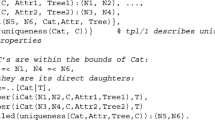Abstract
When the human parser encounters a local structural ambiguity, are multiple structures pursued (parallel or breadth-first parsing), or just a single preferred structure (serial or depth-first parsing)? This note discusses four important classes of serial and parallel models: simple limited parallel, ranked limited parallel, deterministic serial with reanalysis, and probabilistic serial with reanalysis. It is argued that existing evidence is compatible only with probabilistic serial-reanalysis models, or ranked parallel models augmented with a reanalysis component. A new class of linguistic structures is introduced on which the behavior of serial and parallel parsers diverge the most radically: multiple local ambiguities are stacked to increase the number of viable alternatives in the ambiguous region from two to eight structures. This paradigm may provide the strongest test yet for parallel models.
Similar content being viewed by others
REFERENCES
Fodor, J. D., & Inoue, A. (1994). The diagnosis and cure of garden paths. Journal of Psycholinguistic Research, 23, 407–434.
Frazier, L. (1987). Sentence processing: A tutorial review. In M. Coltheart (Ed.), Attention and performance XII: The psychology of reading. East Sussex, U.K.: Erlbaum.
Frazier, L. (1998). Getting there...slowly. Journal of Psycholinguistic Research, 27(2), 123–146.
Gibson, E. A. (1991). A Computational Theory of Human Linguistic Processing: Memory Limitations and Processing Breakdown. Unpublished Ph.D. dissertation, Carnegie Mellon.
Gorrell, P. (1987). Studies of Human Syntactic Processing: Ranked-Parallel Versus Serial Models. Unpublished Ph.D. dissertation, The University of Connecticut, Storrs, Connecticut.
Hickok, G. (1993). Parallel parsing: Evidence from reactivation in garden-path sentences. Journal of Psycholinguistic Research, 22, 239–250.
Just, M. A., & Carpenter, P. A. (1992). A capacity theory of comprehension: Individual differences in working memory. Psychological Review, 99, 122–149.
Kurtzman, H. S. (1985). Studies in Syntactic Ambiguity Resolution. Unpublished Ph.D. dissertation, Massachusetts Institute of Technology, Cambridge, Massachusetts.
MacDonald, M. C., Just, M. A., & Carpenter, P. A. (1992). Working memory constraints on the processing of syntactic ambiguity. Cognitive Psychology, 24, 59–98.
MacDonald, M. C., Pearlmutter, N. J., & Seidenberg, M. S. (1994). The lexical nature of syntactic ambiguity resolution. Psychological Review, 101, 676–703.
Nicol, J. L., & Pickering, M. J. (1993). Processing syntactically ambiguous sentences: Evidence from semantic priming. Journal of Psycholinguistic Research, 22, 207–237.
Pearlmutter, N. J., & Mendelsohn, A. (1998, March). Serial versus parallel sentence processing. Paper presented at the The Eleventh Annual CUNY Sentence Processing Conference, Rutgers University, New Brunswick, NJ.
Spivey, M. J., & Tanenhaus, M. K. (1998). Syntactic ambiguity resolution in discourse: Modeling the effects of referential context and lexical frequency. Journal of Experimental Psychology: Learning, Memory and Cognition, 24, 1521–1543.
Author information
Authors and Affiliations
Rights and permissions
About this article
Cite this article
Lewis, R.L. Falsifying Serial and Parallel Parsing Models: Empirical Conundrums and An Overlooked Paradigm. J Psycholinguist Res 29, 241–248 (2000). https://doi.org/10.1023/A:1005105414238
Issue Date:
DOI: https://doi.org/10.1023/A:1005105414238




